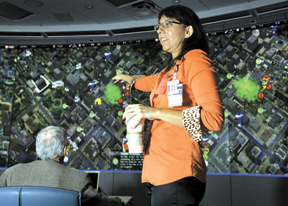
Peanut butter and jelly. Wine and cheese. Dinner and a movie. Some things just naturally go together.
But national security and video games? At first glance, those two aren’t exactly a soft brie and a glass of merlot in terms of compatibility. If Sandia computer scientist and software engineer Donna Djordjevich (8116) has her way, however, perhaps today’s video game-loving youth will become our next generation’s terrorist-fighting scientist, largely due to the game development skills he or she will have learned at Sandia.
Donna is principal investigator of a Laboratory Directed Research and Development project titled “Game Technology-Enhanced Simulation for Homeland Security,” more commonly known as “Ground Truth,” which immerses its users in an interactive gaming environment specifically designed as a training tool for first responders. The program was funded and started in October 2006.
Tapping into video gaming culture
Modeling, simulation, and, yes, gaming, have been around Sandia for years. But Donna, a self-described “obsessive-compulsive gamer,” is a true believer who suggests Sandia could do even more to take advantage of the video game culture, perhaps even integrating gaming in a formal way into the Labs’ homeland security program activities and elsewhere.
“Video games are progressive, intuitive, accessible, and immersive,” says Donna, making them an ideal framework for training and learning. Firemen, police officers, and other first responders, she asserts, are used to being “on the scene” of an incident, so gaming mechanisms that thrust users into a “real” environment are a great fit for training purposes.
Donna started playing her first video game — Super Mario Brothers on the original Nintendo — at age six, on a system purchased by her parents but intended for her brother. She says the “interactive simulation-based” interface offered by video games is more effective than the “press play, then walk away” style of video training.
Ground Truth is part of the “real-time strategy” genre of video games and an example of the “serious games” movement. A 2006 article in the New York Times titled “Saving the World, One Video Game at a Time” asserts that this new generation of video games “can be more than just mindless fun, they can be a medium for change . . . [The movement] is a partnership between advocates and nonprofit groups that are searching for new ways to reach young people, and tech-savvy academics keen to explore video games’ educational potential.”
Visually similar to SimCity
Visually, Ground Truth looks somewhat like the popular “SimCity” city-building simulation game, with a nameless urban environment at the center of the action.
The current scenario involves a chlorine spill; users are required to move pieces around — much like a chess game — in order to best mitigate the consequences of the incident. They can choose from various functional “pieces,” including firefighters, police officers, hazmat teams, or they can activate staging and medical staging areas. If an accident scene requires a roadblock to divert traffic, for example, a user might choose to send the police to the area. Medical staging might be engaged to treat victims, though users need to keep an eye on any toxic fogs that could impact the success of the operation. A “progress thermometer” in the upper right-hand corner of the computer screen helps them gauge the success of their moves. The game takes roughly 20 minutes to play.
Designed for incident commanders
In its current form, says Donna, Ground Truth is designed for high-level incident commanders who need to understand how to best allocate their resources (hence the “big-picture” aerial view on the screen). The game also educates users on the dangers faced by on-scene emergency responders. Those playing the game, for instance, quickly learn that only certain responders are able to wear personal protective gear, so “you don’t want to be sending your police officers into an area where they might face a cloud of toxic gas.” Future scenarios, Donna hopes, will aim to engage personnel who actually respond to scenes, as well as involving decision-makers at higher levels and jurisdictions.
Donna plans to incorporate feedback from authentic emergency response personnel into Ground Truth. Although details were unavailable when Lab News went to press, an August 8 visit to Sandia/California by members of the Alameda County Public Health Department was scheduled, during which a Ground Truth demonstration was planned.
Roughly 10 Sandia staff members, says Donna, are working on Ground Truth, with additional programming, graphics, and animation work being conducted by the University of Southern California’s GamePipe Laboratory (which is hosted by the university’s Viterbi School of Engineering). The project is in its first year of a three-year LDRD commitment.
Though she’s focusing on the work at hand, Donna can’t help but imagine bigger and better things with Ground Truth and the video gaming arena at Sandia.
While Ground Truth may one day become a licensable product that comes on DVD, she envisions DHS Secretary Michael Chertoff being won over by a demonstration and demanding that the program be endorsed, paid for, and delivered by DHS to first responders all over the country. “Then maybe we’ll be ready to launch Sandia’s Center for Interactive Gaming Applications,” she says with a laugh.